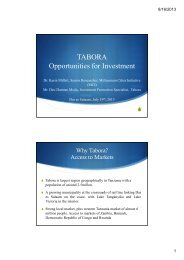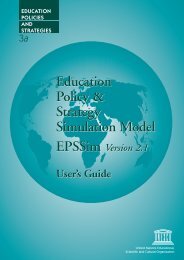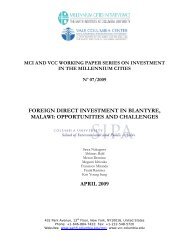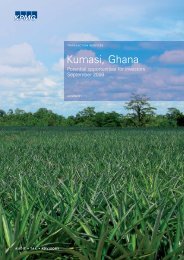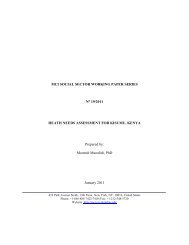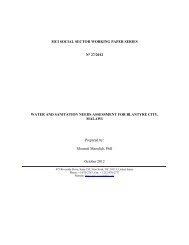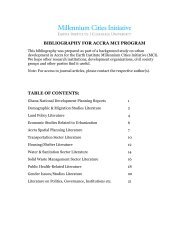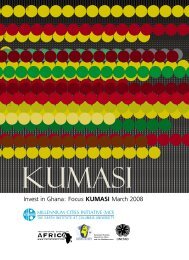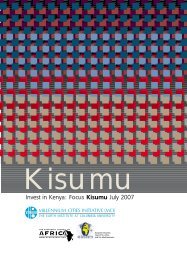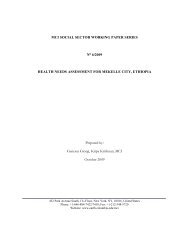Health Needs Assessment for the City of Segou, Mali - Millennium ...
Health Needs Assessment for the City of Segou, Mali - Millennium ...
Health Needs Assessment for the City of Segou, Mali - Millennium ...
You also want an ePaper? Increase the reach of your titles
YUMPU automatically turns print PDFs into web optimized ePapers that Google loves.
Figure 4. Sources <strong>of</strong> Salaries at CSREF F.D. and Hospital N.F. in Ségou<br />
3.2%<br />
12.2%<br />
8.1%<br />
0.3%<br />
Source: DNS (2008).<br />
3. Child <strong>Health</strong><br />
INPS<br />
21.6%<br />
8.9%<br />
M unicipality<br />
ASACO<br />
O<strong>the</strong>r Contract<br />
Technical<br />
Assistance<br />
PPTE<br />
M inistry <strong>of</strong> <strong>Health</strong><br />
Army<br />
Contract<br />
0.5%<br />
3.1. Child Morbidity and Mortality<br />
12.7%<br />
32.4%<br />
Since 1990, vaccination campaigns and o<strong>the</strong>r children’s health promotion ef<strong>for</strong>ts have been<br />
successful, more than doubling <strong>the</strong> proportion <strong>of</strong> children immunized <strong>for</strong> measles. 11 In fact,<br />
Ségou did not record any cases <strong>of</strong> measles in 2006 (CROCEP, 2007). However, child morbidity<br />
and mortality remain pressing issues in Ségou region. Municipal level child mortality data were<br />
not available, but recent surveys such as <strong>the</strong> DHS indicate that <strong>the</strong> rates in <strong>the</strong> Ségou region are<br />
high. In 2006, <strong>the</strong> infant mortality rate 12<br />
was 131 per 1,000 births, and <strong>the</strong> under-five mortality<br />
rate was 151 per 1,000 (DHS-IV, 2006).<br />
Standards <strong>of</strong> care <strong>for</strong> <strong>Mali</strong>’s infant and child health programs follow <strong>the</strong> Integrated Management<br />
<strong>of</strong> Childhood Illness (IMCI), a WHO protocol adopted in 1998. Even though all <strong>of</strong> Ségou’s<br />
facilities do follow IMCI, not all Ségouien families are able to access health care <strong>for</strong> <strong>the</strong>ir sick<br />
children. The DHS-IV in 2006 indicated that only 41 percent <strong>of</strong> all children with an acute<br />
respiratory infection (ARI) received care in ei<strong>the</strong>r <strong>the</strong> public or private sector, only 47 percent<br />
received care <strong>for</strong> a fever, and only 30 percent received care <strong>for</strong> a fever believed to be caused by<br />
malaria.<br />
The diseases that most influence child morbidity rates are malaria, diarrhea, ARIs and<br />
malnutrition. About 19 percent <strong>of</strong> all children in Ségou suffer from diarrhea at any given time<br />
(DHS-IV, 2006); 20 percent <strong>of</strong> <strong>the</strong>se cases are dysentery, and about 40 percent <strong>of</strong> cases result in<br />
dehydration (MDG National, 2008). National figures estimate that, on average, a child will have<br />
11 The measurable increase from 2000 to 2006 is also attributable to <strong>the</strong> fact that city-wide data was finally made<br />
available; Ségou’s average coverage rate is estimated to be higher than <strong>Mali</strong>’s as a whole, which is shown <strong>for</strong> <strong>the</strong><br />
previous decade, in 1990-2000.<br />
12 Rate <strong>of</strong> deaths per 1,000 births <strong>of</strong> babies under 12 months.<br />
15



